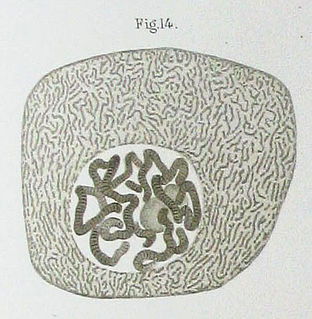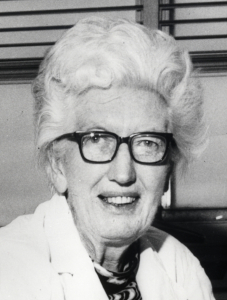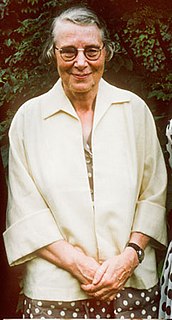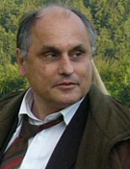Related Research Articles

A chromosome is a long DNA molecule with part or all of the genetic material of an organism. Most eukaryotic chromosomes include packaging proteins called histones which, aided by chaperone proteins, bind to and condense the DNA molecule to maintain its integrity. These chromosomes display a complex three-dimensional structure, which plays a significant role in transcriptional regulation.

The centromere is the specialized DNA sequence of a chromosome that links a pair of sister chromatids. During mitosis, spindle fibers attach to the centromere via the kinetochore. Centromeres were first thought to be genetic loci that direct the behavior of chromosomes.
Heterochromatin is a tightly packed form of DNA or condensed DNA, which comes in multiple varieties. These varieties lie on a continuum between the two extremes of constitutive heterochromatin and facultative heterochromatin. Both play a role in the expression of genes. Because it is tightly packed, it was thought to be inaccessible to polymerases and therefore not transcribed, however according to Volpe et al. (2002), and many other papers since, much of this DNA is in fact transcribed, but it is continuously turned over via RNA-induced transcriptional silencing (RITS). Recent studies with electron microscopy and OsO4 staining reveal that the dense packing is not due to the chromatin.

Karyotyping is the process by which photographs of chromosomes are taken in order to determine the chromosome complement of an individual, including the number of chromosomes and any abnormalities. The term karyotype is also used for the complete set of chromosomes in a species or in an individual organism and for a test that detects this complement or measures the number.
The German National Academy of Natural Sciences Leopoldina, short Leopoldina, is the national academy of Germany, and is located in Halle (Saale). Founded on January 1, 1652, based on academic models in Italy, it was originally named the Academia Naturae Curiosorum until 1687 when Emperor Leopold I raised it to an academy and named it after himself. It was since known under the German name Deutsche Akademie der Naturforscher Leopoldina until 2007, when it was declared to be Germany's National Academy of Sciences. The Leopoldina has a claim to be the oldest continuously existing learned society in the world. The validity of the claim depends in part on how certain definitional and historical questions are answered.

Emil Abderhalden was a Swiss biochemist and physiologist. His main findings, though disputed already in the 1910s, were not finally rejected until the late 1990s. Whether his misleading findings were based on fraud or simply the result of a lack of scientific rigor remains unclear. Abderhalden's drying pistol, used in chemistry, was first described by one of his students in a textbook Abderhalden edited.

Polytene chromosomes are large chromosomes which have thousands of DNA strands. They provide a high level of function in certain tissues such as salivary glands of insects

In genetics, a locus is a specific, fixed position on a chromosome where a particular gene or genetic marker is located. Each chromosome carries many genes, with each gene occupying a different position or locus; in humans, the total number of protein-coding genes in a complete haploid set of 23 chromosomes is estimated at 19,000–20,000.

Charles Weissmann is a Hungarian-born Swiss molecular biologist. Weissmann is particularly known for the first cloning and expression of interferon and his contributions to the unraveling of the molecular genetics of neurogenerative prion diseases such as scrapie, Creutzfeldt–Jakob disease and "mad cow disease".

Berta Vogel Scharrer was an American scientist who helped to found the scientific discipline now known as neuroendocrinology.
Barbara J. Meyer is a biologist and genetist, noted for her pioneering research on lambda phage, a virus that infects bacteria; discovery of the master control gene involved in sex determination; and studies of gene regulation, particularly dosage compensation. Meyer’s work has revealed mechanisms of sex determination and dosage compensation -- that balance X-chromosome gene expression between the sexes in Caenorhabditis elegans that continue to serve as the foundation of diverse areas of study on chromosome structure and function today.

Irene Manton, FRS FLS was a British botanist who was Professor of Botany at the University of Leeds. She was noted for study of ferns and algae.

Gottfried Schatz was a Swiss-Austrian biochemist.

Thomas Cremer, is a German professor of human genetics and anthropology with a main research focus on molecular cytogenetics and 3D/4D analyses of nuclear structure studied by fluorescence microscopy including super-resolution microscopy and live cell imaging. Thomas Cremer is the brother of the German physicist Christoph Cremer and Georg Cremer, Secretary General of the German Caritas Association.
The Schleiden Medal is an award given by the Academy of Sciences Leopoldina, the National Academy of Germany, to honour outstanding achievements in the field of cellular biology. The award is named after botanist Matthias Jakob Schleiden.
Susan M. Gasser is a professor of molecular biology at the University of Basel. From 2004 - 2019 she was the director of Friedrich Miescher Institute for Biomedical Research, where she currently runs a laboratory of quantitative biology studying epigenetic inheritance and genome stability.

Subhash Chandra Lakhotia is an Indian cytogeneticist, academic, Distinguished Professor of zoology, and INSA senior scientist at Banaras Hindu University. He is known for his pioneering researches on Drosophila with regard to its chromosome organization and replication. A Raja Ramanna fellow of the Department of Science and Technology and the Department of Atomic Energy, he is an elected fellow of all three major Indian science academies: Indian National Science Academy, Indian Academy of Sciences and National Academy of Sciences, India. The Council of Scientific and Industrial Research, the apex agency of the Government of India for scientific research, awarded him the Shanti Swarup Bhatnagar Prize for Science and Technology, one of the highest Indian science awards, in 1989, for his contributions to biological sciences.
Robin Campbell Allshire is Professor of Chromosome Biology at University of Edinburgh and a Wellcome Trust Principal Research Fellow. His research group at the Wellcome Trust Centre for Cell Biology focuses on the epigenetic mechanisms governing the assembly of specialised domains of chromatin and their transmission through cell division.
Hans Thoenen was a Swiss neurobiologist best known for his work on neurotrophins.
References
- ↑ "Historical Dictionary of Switzerland - Heitz, Emil". Historical Dictionary of Switzerland . 6 January 2011. Retrieved 9 May 2015.
- ↑ Heitz, Emil (1928). "Das Heterochromatin der Moose". Jahrbücher für Wissenschaftliche Botanik. 69: 762–818.
- ↑ Passarge, E (March 1979). "Emil Heitz and the concept of heterochromatin: longitudinal chromosome differentiation was recognized fifty years ago". American Journal of Human Genetics. 31 (2): 106–15. PMC 1685768 . PMID 377956.
- ↑ "Academy of Sciences Leopoldina - Schleiden Medal - Laureate". Academy of Sciences Leopoldina . Retrieved 9 May 2015.